| Linguistic systems are a consensus of rules which are products of history and usage. This consensus functions in an active and passive capacity: delivering information (speaking and writing) and receiving it (hearing and reading). Because language is an abstract system of signs and symbols, and because context is variable, interpretation is subjective. But there remains broad and mutual agreement on the significance and function of such primary components of (Indo-European) language and grammar as letters and spaces. In the micro space of words and short phrases the function of these fundamental elements is more critical to constructing meaning than in longer passages. The interest of the work lies here, where the absence, presence, rearrangement, or alteration of these small units disturbs linguistic sequence, revealing patterns and systems which exceed and outperform their expected function. | |
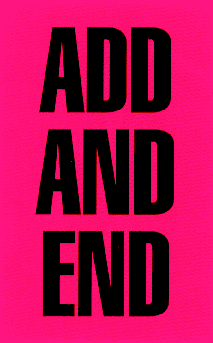
|
Lesson 1 recounts a very economical and succinct little tale from only three words, exhorting its nine letters to create drama from a verb, a conjunction, and a noun. The letter A, followed by two D's, spells ADD. As if the spelling were implementing the meaning, the D's indeed increase or accumulate. In addition, the replacement of the middle D with N, to create the word AND, obeys the directive of ADD by supplementing it with another word. The new word, AND, also satisfies its own definition as a connective, joining word by its position between two words. Substituting E for A, to create the final word END, completes the sequence. The meaning of each word complies with its chronological position. A minimal, almost subliminal, operation of displacing one letter in each word, allows ADD to systematically transform itself into a brief generic narrative, generating a middle and end out of its simple, unspectacular origin. Reading must be active and discerning to distinguish the rudiments of a story in this very condensed text. |
|
Alternative systems of investigating and analyzing language, like my project, sometimes require alternative systems of reading. When a word is restructured nonlinearly, normal methods of decoding (reading) are not sufficient. How does one read TRICKKNEES written like this, with the KK's dislocated on the middle line, similar to the position of the knee cal, on the leg7 What is the significance of this conspicuous realignment, besides its attempted simulation of the body? And what might the slight separation of the components of K suggest? Lesson 2: TRICKKNEES can be pronounced the same way without the K's-TRICNEES. The K's are excessive letters which can be released from any phonetic function to serve as independent agents in a pictorial capacity, like little stick legs. Although the two pairs are in synch with each other, like little dancers, each pair has one "leg" which is awkwardly and unnaturally bent, like the one in the expression of the same name describing a flawed knee which goes out of joint from time to time. Demonstrating their physical capabilities here, the K's act as surrogates or assistants to meaning, helping to convey the sense of the word by single-handedly performing it. The meaning of TRICKKNEES is unofficially about the accidental and coincidental intersection of such formal elements as letter forms with meaning. Because of the convergence of structure and meaning, one might actually come close to understanding the concept of TRICKKNEES merely by observing the K's, without reconstructing the entire word linguistically. |
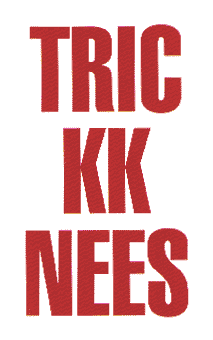
|
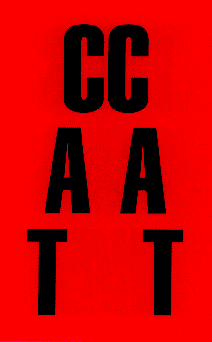
|
In a depleted and stratified arrangement of C's, A's, and T's, the thought of cats might come to mind. But the absence of letters is as important as their presence. One must consider the reason for the intervals. There is a rigorous and efficient logic in all of the work; the choices are not arbitrary. So it is probable that this sparse collection of letters is about something other than cats. Lesson 3: It is odd that STACCATO, a word which concerns intervals of silence between musical notes, contains three pairs of letters, each of which is separated by various intervals of space (other letters). It is not really necessary for the reader to play the game, "Guess the Word"; although I would be very impressed by someone who figured out that this word was STACCATO without having read the title. Rather, it interests me more to pass on this new information about STACCATO to the reader: that the formal structure of its letters and its meaning are parallel. This occurrence is not a function of formal rules, but an independent event in which letters double as musical notes of different time values. In order to reconstruct meaning, the reader is invited to become a viewer, to see and to reason rather than to read, that the C's, A's, and T's and their intermittent symmetrical positions in the word are more aligned with tempo and musical considerations than with linguistic ones. This structural complement to the meaning of STACCATO serves as an extra-linguistic spine or armature which may be invisible in complete, linear words, but which, when isolated and exposed, inadvertently confirms and reinforces meaning. There seems to me to be something very ethical about a word which can offer this sort of structural evidence to support its meaning, and visually validate and corroborate its conceptual intent. |
|
Lesson 4: This stack of fragments looks like exclamations from a comic strip-something between OUCH and UGH-partial and inarticulate expressions of disgust or pain. But their neat, clean-cut margins make them appear to have been surgically, aesthetically, and conceptually removed from larger words. Without the rest, one can only speculate about what they mean or how they sound. It is a very literal attempt to show how critical context is to meaning. Not only is the surrounding text important, but so is the larger context: historical, cultural, political, the medium, the voice of the author, the identity of the audience. All contribute to and impact on meaning, organically shaping and manipulating it, but never allowing it to harden and dry. When reinserted into the three words ROUGHLY THOUGHT THROUGH, the fragments become semantically distinct and phonetically coherent. They react to the letters which precede and follow, changing their vowel sounds from U (ruffly) to 0 (thot) to 00 (THROO). When activated by adjacent letters, the phrase can be read normally. Otherwise it can only be addressed in terms of deficiency. Yet deficiency is the message of the phrase. Information is never complete. There always remain elusive and inaccessible ingredients outside of one's field of knowledge which prevent complete comprehension. In a reduced and partial context, ideas are incapable of being thoroughly thought through. |

|
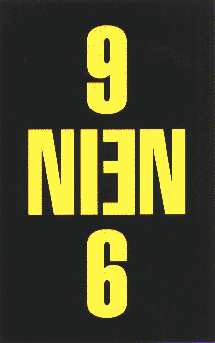
|
Reading numbers such as 9 and 6 is indisputable until they are considered along with the upside down word NEIN. Maybe the numbers are inverted as well and should be 6 and 9? Nevertheless, the phrase indicates a need for correction, both in the "answers" and in the vertical orientation of the word. If the page is turned, so that NEIN reads right side up, our and its position are reconciled visually; and we feel comfortable with our mutual alignment. But this solution corrects only the orientation system of the page, not the number sequence. They remain the same wrong and right answers, 9 and 6; and the rest of the magazine is out of whack. If only the text (and not the page) is mentally inverted to read 6 NEIN 9, the orientation of NEIN is resolved, and the magazine is in tact. But the new numbers are still "incorrect"; we are still told NEIN. To confound this binary ambiguity even more, consider the word NEIN, which means NO in this form, but sounds and looks like a slightly rearranged version of the English number NINE (9). Is it possible that this is not an issue of translation, orientation, or arithmetic after all, but simply an incident of misspelling, which should read instead 9 NINE 6 (996) or 6 NINE 9 (699)? Lesson 5: Function and position in relation to a system are complex and uneasy. Criteria and methods of orientation are conditional. Complete agreement and accommodation are unlikely. |
|
Lesson 6: A background in languages, comparative linguistic analysis, and applied linguistics provides a rigorous method and discipline for scrutinizing language, for focusing on the smallest mechanisms by which it operates, and for dissecting and analyzing almost invisible components of language. But academia does not furnish a sympathetic framework or audience for investigating and presenting alternative ideas which come from digging around in language and excavating unnoticed sub-systems which operate independently of authorized rules. Nor does it seem to be entertained by linguistic events which are odd or funny because of the rules. Because many of these unintentional sub-systems and events are revealed and understood through seeing, it is useful, but incompatible with that system, to present this information visually, through painting, drawing, or the visual page. It is remarkable how written information can also be processed through deductions and associations, relying very little on the learned, cognitive process of reading. Visual strategies of grammar and typography such as spacing, upper and lower case, punctuation, type size and boldness, letter forms, and layout are critical to interpretation, but improper academic issues. They can contribute significantly to the way information is received, as can such concerns of art as color, surface, composition, scale. They may not have much to do with linguistic structure; but they are capable of structuring meaning visually, through emphasis or de-emphasis, for example. They function as much like signs and directives for reading as do phonemes. But they are not even a blip on the screen of the academic study and teaching of languages. An alternative to changing the system, working uneasily within it, or leaving it entirely was to combine the paradigm of the classroom or "laboratory" with that of the studio, inventing a hybrid from elements of both. |
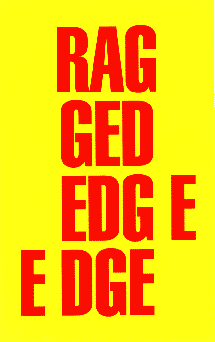
|
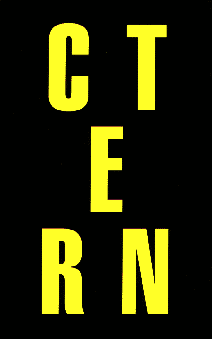
|
It is improbable that one belongs to a singular system. And within the larger category of Art, there are clearly multiple subdivisions. Where an artist fits is questionable and variable, whether it is her stated concern or not. Like many others, I have not intended to actively or consciously define an agenda or negotiate a position. Those classifications are often constructed externally by others from perceptions about artists and perceptions of trends and issues, for example: language in art, women in art, women who use language in art, women who claim authorship of language, women who teach, women who paint, gender as an issue in painting, small painting as a gender issue, medium as message, hidden messages, word as image, word as concept and image, the sign as page, the page as sign, the canvas as sign and page, unauthorized voices, art on the edge, art on the fringe, outsider art, alternative messages, humor in art, humor by women, humor in work by American women. All of these constructs can be used to define a (1) woman who (2) paints (usually) (3) small (usually) (4) images of language (mostly English), which because of their authorship, content, size, and process lie neither within historically validated categories of painting nor within historically validated categories of linguistics. Lesson 7: If one reads this page diagonally from upper left to lower right (C-E-N) and upper right to lower left (TE-R), she reads CENTER; and there appears to be one big E in the middle. But the movement of the eye makes an X. No, it suggests. There is not one center, but two. There is an E in the middle of each syllable. CENTER is plural. |
|
Lesson 1 began with the work's intention of discovering and analyzing new visual and linguistic systems in brief verbal fragments. Because every mark that is made on a page creates meaning, shorter constructions generally provide stricter and more rigorous limits and controls on interpretation than do longer ones. This last lesson offers a very literal scenario on the polemics of size. The dispute concerns quantity-the sum of letters/numbers per line, nine or ten, which is indicated by the final number expressed on that line. For example, N-1-N-E-N-E-1-N-1-0 does indeed contain ten figures. Each line attempts to be specific, clear, and correct in its procedure and solution, enlisting a variety of strategies, such as reiteration, translation, and enumeration to make its case. But in spite of their insistence, the voice or voices contradict themselves and each other. Their disagreement is a consequence of expression. The subtraction or addition of each unit of meaning, each letter or number, increases or decreases the length of the argument and thus, the conclusion. Lesson 8 is a farcical and elaborate conceit about the behavior of language and its inability to be absolute, certain, and consistent. Moreover, it demonstrates how critical the smallest components are to this behavior. |
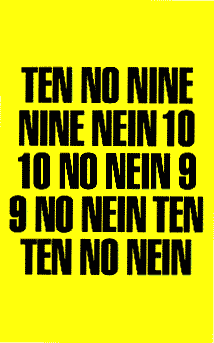
|